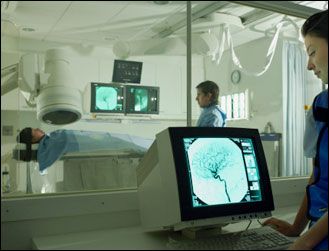十大创新技术将变革医学健康模式
最近,哈佛商业评论评价了健康医疗领域十大未来创新科技,可能真正改变医疗健康时代。
1、 检查清单
2、 行为经济学
3、 患者门户
4、 支付创新
5、 循证决策
6、 责任医疗组织
7、 再生医学
8、 虚拟就诊
9、 遗传医学
10、 手术机器人
英文全文:
If ever a field needed a makeover, it’s medicine. Chaotic, expensive, inefficient, and often ineffective, health care is dying for innovation. There’s no shortage of clever ideas, but, as we will be discussing online in the coming weeks, barriers to innovation — everything from heart-stopping price tags for new technologies to doctors’ famous crankiness about doing things differently — are just as abundant.

Checklists Health care is catching on to something pilots have known for decades — that by taming complexity, checklists can save lives. In his best seller The Checklist Manifesto, surgeon Atul Gawande describes how using a simple checklist before surgery can help hospitals catch stupid mistakes before they happen (are we operating on the right patient?), reducing deaths nearly half. Achecklist tested at Johns Hopkins Hospital required doctors to confirm, among other things, that they’d washed their hands before inserting a central line. Incredibly, when doctors used the list, the 10-day line-infection rate fell from 11% to zero. So using checklists is a no-brainer, right? I asked Gawande about that. The good news, he told me, is that they’re being adopted pretty fast compared with other innovations in medicine (it took more than a decade for aspirin to become a routine part of heart-attack care). The bad news is that if you try to mandate checklists “it will fail,” Gawande says. Hospitals need to sell docs on the value of checklists and, more difficult, get them to step off the pedestal and become team players, comfortable in a world where a nurse can tell them to go wash their hands.

Behavioral Economics If we all acted rationally, we’d eat right, floss, and take our pills as directed. But of course we can be pretty disobedient about doctors’ orders, which not only is bad for our health but costs hundreds of billions of dollars a year. Behavioral economics tools —gentle prods that nudge us to behave in desired ways — may be more effective than any amount of browbeating by doctors. In a recent HBR blog, John Sviokla and colleagues described how reminders, social pressure, default options, rewards, and other behavioral tricks can be used to improve compliance in stroke and diabetes patients and, surely, anyone else who drops the self-care ball from time to time. Doctors, too, can be nudged as needed to improve care. The experience of one large practice at Partners HealthCare in Boston shows the impact of peer pressure: Showing a group of doctors the huge variation in their individual use of a certain radiology test — which exposed a handful of particularly heavy users — reduced test use by 15%.
{nextpage}

Patient Portals The idea of organizing all your health information in one place online and coordinating your health-related business from there looks great on paper. Patients could log on to their own secure portal, access and share their medical records, check lab results, renew prescriptions, deal with insurers, and communicate with doctors and nurses. In fact, there are many such patient portals up and running or in the works, Microsoft HealthVault and Google Health among them, promising (as Google puts it) to help you “take charge of your health information.” That can only be a good thing, and the potential for reducing mistakes, inefficiency, and costs is clear. But asRobert Steinbrook pointed out in the New England Journal of Medicine, so is the potential for privacy, security, and liability headaches that could stall wide acceptance.

Payment Innovations “If automakers were paid by the bolt, cars would be brimming with bolts,” Harvard Medical School professor Jeff Levin-Scherz writes in the April 2010 Harvard Business Review. In the U.S., we pay for health care “by the bolt,” shelling out for units of service rather than results, rewarding volume over value, and encouraging extra visits, procedures, and tests. Some studies show that salaried physicians, who have nothing to gain by doing lots of tests and procedures, do fewer of them than doctors paid on a fee-for-service basis. Arrangements that pay a set rate per patient regardless of what services the patient gets can also rein in procedures and costs. Other models offer doctors monetary incentives for keeping their patients healthy. But as Tom Lee, author of Chaos and Organization in Health Care, notes, there’s no one payment system that will work in every setting — and, indeed, “any time money changes hands, perverse things can happen.” What we do know is that the payment system is badly broken, and any hope for affordable, quality care lies partly in payment reform.
{nextpage}

Evidence-Based Decision Making It’s unsettling to be reminded that doctors’ decisions aren’t always (or even usually) evidence-based. The mere fact the treatments for a condition vary enormously from one region to the next is proof enough of that. Electronic medical records offer one way to help align what doctors do and what the best evidence says they should do. (If you get care in a big health system, you may have seen your doctor using EMR technology, entering data into a tablet computer as she took your history.) At a basic level, EMRs simply gather and organize health information. But at their best they offer “decision support,” reminding the doctor of a test you might need, pointing out a worrisome trend in your health history, warning against prescribing the wrong drug, and providing instant access to textbooks and journals. The technology seems like a sure thing — but the jury’s still out on whether EMRs actually improve quality of care. Betting that they will, the Obama administration has earmarked $19 billion to put EMRs into doctors’ hands.

Accountable Care Organizations The fact that you’d have to label a health organization “accountable” — as opposed to what, exactly? — throws the quality challenge into sharp relief. Most health care is designed to treat you when you’re sick. But — and this might sound crazy — imagine an organization whose job was to keep you healthy and out of the hospital, and actually rewarded its doctors and hospitals when they did. It’s an idea that’s generating a lot of buzz in Washington. The Medicare Payment Advisory Commission devoted a chapter of its hefty June 2009 report to Congress to the ACO concept, pitching it as a carrot-and-stick approach to improving quality and lowering costs: If members hit cost and quality targets for a group of patients, they get a bonus; if the providers fall short, Medicare could hold some money back. The health reform bill mired in Congress includes plans for a pilot program and private-sector ACO experiments are under way. Whatever mechanism works in the end, the idea of giving doctors incentives to keep us healthy seems both brilliant and obvious.
{nextpage}

Virtual Visits Now that Skyping your friends in Sydney is routine, it seems that televisiting your doctor will just be a matter of time. Judging from the ubiquitous Cisco ads, in which Ellen Page televisits her doctor in Denmark from Nova Scotia, that time is (virtually) here. Cisco has tested its technology in the U.S. and abroad, and launched a new commercial system this month. Ronald Dixon, director of the Virtual Practice Project at the Massachusetts General Hospital, has found that doctors and their patients readily take to televisiting, which could become a component of patient portals. Virtual visits won’t replace the real thing anytime soon — you can’t palpate a swollen abdomen over the TV (yet) — but current systems do allow doctors to capture various health data, like blood sugar, blood pressure, and heart rate, while videoconferencing with a patient. The convergence of convenience, low cost, and the potential to enrich doctor-patient relationships could move televisiting into the mainstream. What stands in the way? Says Dixon, “We just need to change the rules and overcome the lingering cultural barriers that currently prevent it.”

Regenerative Medicine You know the principle: Stem cells, which can transmute into any type of tissue — muscle, liver, bone, what have you — can potentially cure an array of devastating, once intractable conditions, from cancer to multiple sclerosis to spinal cord injuries. And you know the problem: One important source of stem cells is human embryos. Enough said. One work-around is to cultivate stem cells from amniotic fluid, umbilical cords, or adult tissues, and, indeed, some treatments based on nonembryonic stem cells already appear effective. Last month, for example, the BBC reported that a 43-year-old British man with leukemia was successfully treated with umbilical cord cells. And MS patients in a small clinical trial improved after treatment with stem cells collected from their own bone marrow. There’s every reason to be optimistic about the prospects for stem cell therapy, but the devil is in the details.
{nextpage}

Surgical Robots Few medical technologies embody the ethos of “newer is better” more than operating-room robots do. With price tags often easily topping $1 million, surgical robots promise to help surgeons squeeze into tight places, performing minimally invasive repairs that, in theory, should lead to better outcomes. Operating-room robots have been around for decades, assisting in everything from heart surgery to kidney transplants, even allowing surgeons to work from remote locations. (In 2001 a surgeon in New York removed a woman’s gallbladder—in France.) That they work is clear; whether they’re always better than the old-fashioned approach is hazier. Take the area of prostate cancer surgery, where robots reportedly now assist in the majority of the 85,000 procedures each year in U.S. The robot surgeries typically take longer and cost more than conventional ones, yet no hard data show that patients do better overall when a robot’s involved. Meanwhile, doctors and medical centers are enthusiastically advertising their robotic offerings, and patients are demanding them. Robots will become increasingly common (and expected) in ORs — yet it may be years before we know how well they work.

Genetic Medicine It’s wise to avoid the terms “holy grail” and “breakthrough” in discussing any therapy. But, truly, both apply to attacks on disease at the gene level. There are two big ideas here: One is to replace defective genes with working ones; the other is to tailor drug treatment to your specific genetic profile, creating customized cures. Of course, efforts to deliver on both counts have been bedeviled by technical challenges and worse. Some early gene therapy experiments killed their subjects. Yet recent successes have been astonishing, notably gene therapy cures for children with severe combined immunodeficiency disease — the so-called bubble-boy disease. And the field of pharmacogenomics is similarly advancing, allowing doctors to select drugs and doses based on genetic profiles, with, as always, promising but mixed results. A wonderful New York Times serieslast month traced the wrenching trials of one such tailored drug for melanoma. The question is when, not if, genetic medicine will become routine.
相关知识
AI技术革新,重塑健康管理方式
十大生物技术将改善人类健康
专家:大数据时代血糖管理模式将迎来重大变革
AI智变,未来健康——2024WAIC医疗大模型创新发展论坛即将举办!
健康旅游的新技术、新模式、新业态
勇立潮头锐意创新——医学院“双语”教学改革创新十年之路
健康产业的大变革
移动科技给医疗保健业带来的十大大变革
C-Life创新赋能美业全场景变革,美业AIGC时代真的来了!
智慧医疗:科技助力健康未来的革新力量
网址: 十大创新技术将变革医学健康模式 https://www.trfsz.com/newsview207029.html
推荐资讯
- 1男女激情后不宜做哪些事 3842
- 2从出汗看健康 出汗透露你的健 3826
- 3早上怎么喝水最健康? 3623
- 4习惯造就健康 影响健康的习惯 3277
- 5五大原因危害女性健康 如何保 3177
- 6连花清瘟、布洛芬等多款感冒药 2953
- 7男子喝水喉咙里像放了刀子一样 2451
- 810人混检核酸几天出结果?1 2221
- 9第二轮新冠疫情要来了?疾控中 2215
- 10转阴多久没有传染性?满足四个 2159






